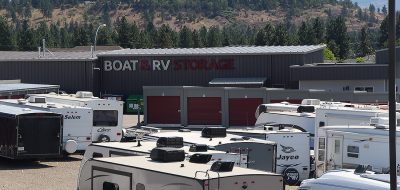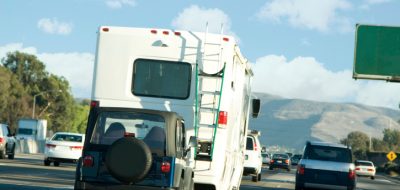Customizing, or personalizing, your motor home can take many shapes, sizes and sounds. If you’re adding air horns it may deliver all three. But the emphasis is on the sound if you are thinking of the ultimate train horns. They are so loud they will mask even a pair of Hadley air horns. So loud that you will need an override switch to disconnect them under some circumstances. They can be added to an existing diesel pusher’s air horn system or to a gas powered rig with the addition of a stand-alone air compressor.
So where do you get them? Though I’m sure there are several suppliers of these three horn bad boys, I got mine at The Great American Chrome Shop, in Florida. The units come complete with securing hardware and a 12 volt solenoid controlled air valve.
 Newmar, and perhaps other coach builders, are installing the two normally roof mounted Hadley air horns behind the generator slide out in the front of their high line coaches. This is being done on their high line models from 2008 forward. I’m not sure why they moved them from the roof as I thought they looked pretty cool there. So this is the place that I installed the new additional set and they fit perfectly. I mounted them pointing down and slightly forward. That way the sound would have a clear path beneath the slide face to the pavement below the front cap. This was done on the left, or driver side, of the generator. This position happens to be directly in front of the standard fitted electric horn set and the pneumatic solenoid valve that supplies the roof mounted units.
Newmar, and perhaps other coach builders, are installing the two normally roof mounted Hadley air horns behind the generator slide out in the front of their high line coaches. This is being done on their high line models from 2008 forward. I’m not sure why they moved them from the roof as I thought they looked pretty cool there. So this is the place that I installed the new additional set and they fit perfectly. I mounted them pointing down and slightly forward. That way the sound would have a clear path beneath the slide face to the pavement below the front cap. This was done on the left, or driver side, of the generator. This position happens to be directly in front of the standard fitted electric horn set and the pneumatic solenoid valve that supplies the roof mounted units.
 For ease of installation, I choose to plumb the air valve with an air line plugged into the forward quick disconnect. This would also allow me to instantly disable the entire unit should the valve fail in any way. The Newmar diesel pushers are equipped with a dash switch that is wired to by-pass the roof mounted air horns if needed. Therefore in the standard factory wiring configuration, the automotive type electric horns are the default with the roof air horns selectable to operate in addition. For this I choose to disconnect the electric horns and reconnect those to the terminals on the roof horn actuation valve. To do this I had already removed the wires that originally went to the roof horn valve and routed them to the valve that operates the train horns. Now the dash switch could be used to enable or disable the train horn set and the new default would be the Hadley roof mounted horns.
For ease of installation, I choose to plumb the air valve with an air line plugged into the forward quick disconnect. This would also allow me to instantly disable the entire unit should the valve fail in any way. The Newmar diesel pushers are equipped with a dash switch that is wired to by-pass the roof mounted air horns if needed. Therefore in the standard factory wiring configuration, the automotive type electric horns are the default with the roof air horns selectable to operate in addition. For this I choose to disconnect the electric horns and reconnect those to the terminals on the roof horn actuation valve. To do this I had already removed the wires that originally went to the roof horn valve and routed them to the valve that operates the train horns. Now the dash switch could be used to enable or disable the train horn set and the new default would be the Hadley roof mounted horns.
Well, then came the test. I first blew the horn with the air horn by-pass switch in the off position. It worked in the manner I had set it up, only the roof mounted Hadley’s droned out their deep throated blast. Now, with the switch on, I again activated the horn. Wow! In a deafening tri-tone blast, the train horns masked even the Hadley’s, which were also trumpeting to the best of their ability. It was then that I realized the by-pass switch was a must as these were far too loud to use on any city or town street. They were definitely so loud one would only attempt to use them out on the highway. I had heard a rumor that some states had banned the use of these “Bad Boys”, and I certainly could believe it. If you ever pulled the trigger when near a railroad crossing, the traffic would surely slam their brakes on and look bewildered.
Well, never mind the law. Believe it or not, my dog will not allow me to use them. At least without getting so frightened that she will shake for an hour or so and will not get back in the coach. Now that is really saying something. Mysty, our Wire Haired Fox Terrier, is not afraid of anything. Whether it is loud thunder, high cranked volume of surround sound or just about anything else, she is not disturbed. There are only two sounds she can not deal with, loud motorcycles and now, the train horns.
So, anyway, that’s the story on the train horn project. It was fun planning it, it was fun installing them, and it was super fun testing them. If you’re looking for an add-on project for your coach, go for it. And just remember where you HEARD IT!
Just Blowing My Own Horn, – Lug_Nut – Peter Mercer







John
Hi Lug_Nut,
I have to agree with you regarding the inabiltiy of drivers to be able to hear the driving environment around them. And it seems to be getting worse these days by increased use of cell phones, ipods and blackberrys.
Drivers that don’t pay attention while using these units are endangering their lives and of others. I think even they would appreciate a blast of the air horn to avoid being involved in a potentially deadly motor vehicle accident. Their shorts may get soiled in such an incident which may cause them to reconsider their useage. At least they’ll be alive the see another day.
Will see about one for my coach in ’09.
Cheers,
John
Lug_Nut
Hi John Shelton, The loud horn may in fact be needed on the highway. I have experienced, several times, vehicles, including truckers, that apparently can’t hear. Perhaps they have their radio or iPod blasting, I don’t know. But, if you have the experience you claim to have, I’m sure you know what I;m saying. Loud horns may be needed for hard to get people’s attention. Let’s not make it any more complicated than it is.
Thanks for your great input.
John Shelton
I found your article on train horns interesting, if not much more. I have been driving RV’s of various descriptions for more than 30 years and also driving tractor-trailer trucks for much of this time. My observation concerning this extremely loud horn issue is this: What does a vehicle as large and inherently conspicuous and obvious (to nearby traffic) as a large motorhome or highway truck need with a 120 db air horn to start with – – much less a 150 to 170 db train horn? If a courteous beep-beep doesn’t correct whatever you are trying to use your horn to correct, a discourteous and often disturbing HOOOONK will, far more often than not, just make matters worse. Let us, as RV’ers, do our part to reduce road rage, not encourage and inflame it. That’s my story, and I’m sticking to it.
p.s. It is my understanding that in some jurisdictions it is illegal to have these horns which are not approved for highway use even mounted on a highway vehicle, whether they are operational or not. It is even a greater offense to use them in these jurisdictions.
Lug_Nut
Hi John, Years ago I drove a 5 cubic yard rubber tired loader over the entire front end of a 3/4 ton truck when the brakes failed due to icing within the system. I was put alcohol in the system every hour, but I guess it wasn’t enough. Anyway, nobody was hurt, just scrapped the truck.
No, the additional air needed to operate the extra horns appear not noticable. Thanks for your great input John.
John
Hi Lug_Nut,
Reminds me when I was long hauling and had to use the rigs air horn to scare Elk off the Trans Canada Hwy. near Lake Louise. I found one day when I had to use them, they wouldn’t work properly. I narrowed it down to moisture in the horns. I noticed you mounted yours sloping down which as you say gives the sound a good direction but also drains any moisture from the horns. When driving between Vancouver and Calgary in winter you can go through as many as a dozen or more weather changes from 45 degrees below zero to 15 degrees above freezing. Often air systems would freeze relay valves and air horns, even if you had an air dryer. One way around this was to pour a few ounces of methyl hydrate into the tractors glad hands (air lines) and reconnect them to the trailer.
After a few brake applications and a couple of minutes all was well again. I’m not familiar with a coach’s air system, but if anyone has moisture in their air system they may try a bit of methyl hydrate by opening a line and pouring some in. Also if you have a drain valve on your air tank, use it from time to time, you may be surprised what can come out. It also can give you an early indication of the state of the air compressor rings if there is a trace of oil in the draining water.
Oh yes, I almost forgot to ask you if you noticed a sizeable drop in your air pressure when blasting the horn?
Thanks for the informative article.
Cheers,
John
Lug_Nut
Ken, I don’t know which exact model they were, but I think it was the only triple train horn set The Great Ameriacn Chrome Shop, in Florida had. They are capable of about 152 decibels.
Ken
Pete,
Exactly which brand and model number air horns did you buy??
Ken
Lug_Nut
Larry, I guess that would surely get their attention. Thank you for your input. It is so nice to hear from readers as this is an interactive site and this is the way we all learn by sharing our experiences.
Larry
I had a 34 ft. Bounder new in 1989 until I retired in 2000, I put my air hors behind the grill on drivers side about the even with the back window of a car when it pulled in front of me, most drivers never stayed close to the front of my Bounder.